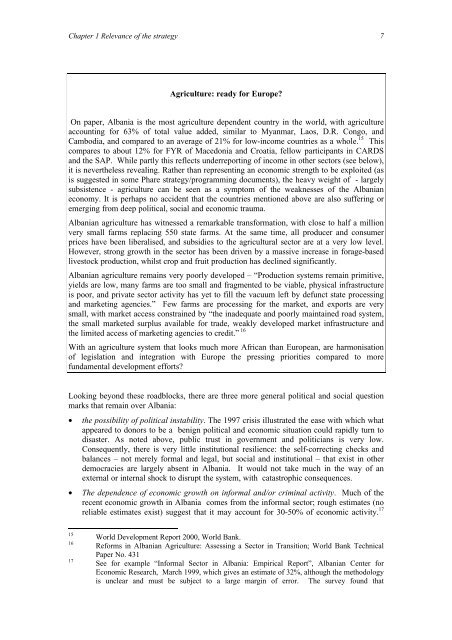Final Report - European Commission - Europa
Final Report - European Commission - Europa
Final Report - European Commission - Europa
Create successful ePaper yourself
Turn your PDF publications into a flip-book with our unique Google optimized e-Paper software.
Chapter 1 Relevance of the strategy 7<br />
Agriculture: ready for Europe?<br />
On paper, Albania is the most agriculture dependent country in the world, with agriculture<br />
accounting for 63% of total value added, similar to Myanmar, Laos, D.R. Congo, and<br />
Cambodia, and compared to an average of 21% for low-income countries as a whole. 15 This<br />
compares to about 12% for FYR of Macedonia and Croatia, fellow participants in CARDS<br />
and the SAP. While partly this reflects underreporting of income in other sectors (see below),<br />
it is nevertheless revealing. Rather than representing an economic strength to be exploited (as<br />
is suggested in some Phare strategy/programming documents), the heavy weight of - largely<br />
subsistence - agriculture can be seen as a symptom of the weaknesses of the Albanian<br />
economy. It is perhaps no accident that the countries mentioned above are also suffering or<br />
emerging from deep political, social and economic trauma.<br />
Albanian agriculture has witnessed a remarkable transformation, with close to half a million<br />
very small farms replacing 550 state farms. At the same time, all producer and consumer<br />
prices have been liberalised, and subsidies to the agricultural sector are at a very low level.<br />
However, strong growth in the sector has been driven by a massive increase in forage-based<br />
livestock production, whilst crop and fruit production has declined significantly.<br />
Albanian agriculture remains very poorly developed – “Production systems remain primitive,<br />
yields are low, many farms are too small and fragmented to be viable, physical infrastructure<br />
is poor, and private sector activity has yet to fill the vacuum left by defunct state processing<br />
and marketing agencies.” Few farms are processing for the market, and exports are very<br />
small, with market access constrained by “the inadequate and poorly maintained road system,<br />
the small marketed surplus available for trade, weakly developed market infrastructure and<br />
the limited access of marketing agencies to credit.” 16<br />
With an agriculture system that looks much more African than <strong>European</strong>, are harmonisation<br />
of legislation and integration with Europe the pressing priorities compared to more<br />
fundamental development efforts?<br />
Looking beyond these roadblocks, there are three more general political and social question<br />
marks that remain over Albania:<br />
• the possibility of political instability. The 1997 crisis illustrated the ease with which what<br />
appeared to donors to be a benign political and economic situation could rapidly turn to<br />
disaster. As noted above, public trust in government and politicians is very low.<br />
Consequently, there is very little institutional resilience: the self-correcting checks and<br />
balances – not merely formal and legal, but social and institutional – that exist in other<br />
democracies are largely absent in Albania. It would not take much in the way of an<br />
external or internal shock to disrupt the system, with catastrophic consequences.<br />
• The dependence of economic growth on informal and/or criminal activity. Much of the<br />
recent economic growth in Albania comes from the informal sector; rough estimates (no<br />
reliable estimates exist) suggest that it may account for 30-50% of economic activity. 17<br />
15<br />
16<br />
17<br />
World Development <strong>Report</strong> 2000, World Bank.<br />
Reforms in Albanian Agriculture: Assessing a Sector in Transition; World Bank Technical<br />
Paper No. 431<br />
See for example “Informal Sector in Albania: Empirical <strong>Report</strong>”, Albanian Center for<br />
Economic Research, March 1999, which gives an estimate of 32%, although the methodology<br />
is unclear and must be subject to a large margin of error. The survey found that
















